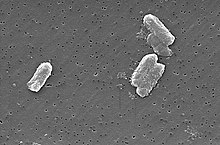Citrobacter
| Citrobacter | |
|---|---|

| |
| Citrobacter freundii | |
| Scientific classification | |
| Domain: | Bacteria |
| Phylum: | Pseudomonadota |
| Class: | Gammaproteobacteria |
| Order: | Enterobacterales |
| Family: | Enterobacteriaceae |
| Genus: | Citrobacter Werkman and Gillen, 1932 |
| Species | |
Citrobacter is a genus of Gram-negative, aerobic, rod-shaped[2] coliform bacteria of the Enterobacteriaceae family.
Citrobacter spp. cause opportunistic infections (including urinary tract infections, gastroenteritis, and bacteremia).[2]
Microbiology
[edit]Microbial biochemistry
[edit]The species C. amalonaticus, C. koseri, and C. freundii can use citrate as a sole carbon source. Citrobacter species are differentiated by their ability to convert tryptophan to indole (C. koseri is the only citrobacter to be commonly indole-positive), ferment lactose (C. koseri is a lactose fermentor), and use malonate.[3]
Citrobacter shows the ability to accumulate uranium by building phosphate complexes.[4]
Environmental microbiology
[edit]These bacteria can be found almost everywhere in soil, water, wastewater, etc. They can also be found in the human intestine.[5][6]
Clinical significance
[edit]Citrobacter are considered opportunistic nosocomial pathogens, typically associated with urinary tract infections and infant meningitis and sepsis.[7]
Antimicrobial resistance
[edit]Citrobacter freundii strains have inducible ampC genes encoding resistance to ampicillin and first-generation cephalosporins.[8] In addition, isolates of Citrobacter may be resistant to many other antibiotics as a result of plasmid-encoded resistance genes.[7]
References
[edit]- ^ a b c Parte, A.C. "Citrobacter". LPSN. Retrieved 18 October 2018.
- ^ a b "Dictionnaire médical de l'Académie de Médecine" [Medical Dictionary of the Academy of Medicine]. www.academie-medecine.fr (in French). Retrieved 2024-01-13.
- ^ Lipsky, Benjamin A.; Hook III, Edward W.; Smith, Arlene A.; Plorde, James J. (1980). "Citrobacter Infections in Humans: Experience at the Seattle Veterans Administration Medical Center and a Review of the Literature". Clinical Infectious Diseases. 2 (5): 746–760. doi:10.1093/clinids/2.5.746. ISSN 1058-4838. PMID 6763304.
- ^ Macaskie, Lynne E.; Empson, Ruth M.; Cheetham, Anthony K.; Grey, Clare P.; Skarnulis, A. Jerome (1992). "Uranium bioaccumulation by a Citrobacter sp. as a result of enzymically mediated growth of polycrystalline HUO2PO4". Science. 257 (5071): 782–784. Bibcode:1992Sci...257..782M. doi:10.1126/science.1496397. ISSN 0036-8075. PMID 1496397.
- ^ Drelichman, Vilma; Band, Jeffrey D. (1985). "Bacteremias due to Citrobacter diversus and Citrobacter freundii. Incidence, risk factors, and clinical outcome". Archives of Internal Medicine. 145 (10): 1808–1810. doi:10.1001/archinte.145.10.1808. PMID 3899035.
- ^ Badger, Julie D.; M.F. Stins, Monique F.; Kim, Kwang Sik (1999). "Citrobacter freundii Invades and Replicates in Human Brain Microvascular Endothelial Cells". Infection and Immunity. 67 (8): 4208–4215. PMC 96726. PMID 10417193.
- ^ a b Jabeen, Ishrat; Islam, Sohidul; Hassan, A. K. M. Imrul; Tasnim, Zerin; Shuvo, Sabbir R. (2023). "A brief insight into Citrobacter species–a growing threat to public health". Frontiers in Antibiotics. 2. doi:10.3389/frabi.2023.1276982/full. ISSN 2813-2467.
- ^ Meini, Simone; Tascini, Carlo; Cei, Marco; Sozio, Emanuela; Rossolini, Gian Maria (2019). "AmpC β-lactamase-producing Enterobacterales: what a clinician should know". Infection. 47 (3): 363–375. doi:10.1007/s15010-019-01291-9. ISSN 1439-0973.
